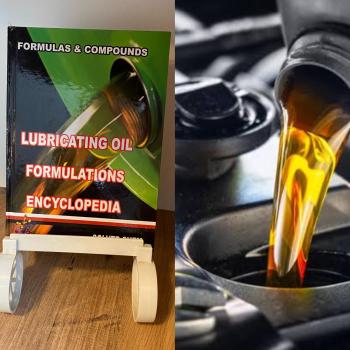
An improperly lubricated engine may suffer from excessive heat, wear and noise, and will often fail if the issue is not resolved. Upon adding a lubricating fluid to an engine, the very operation of that engine begins to impact the functionality of the oil. An example of this is the degradation of lubricating oil by the presence of fuel contaminants such as gasoline, diesel and biodiesel.

Table 1. Equipment
Flash Point Testing
One traditional technique used to determine fuel dilution is flash point testing (D92, D93, D56), which determines the reduction in the flash point temperature due to the presence of lighter hydrocarbon fuel components. However, if the fuel type or type of new engine oil is not known, this technique can report uncertain results. These results are typically recorded as pass/fail or positive/negative. While flash point data provides important information, determining an actual percentage of fuel dilution in the lubricating oil may still be necessary.
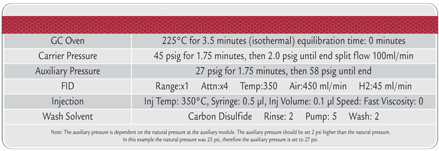
Table 2. Conditions
Gas Chromatography
A second method for testing fuel dilution is gas chromatography (GC). In this method, the lubricating oil is injected directly into a GC according to ASTM D3524, ASTM D3525 or DIN 51380. This technique may be beneficial over flash point testing because quantitative and qualitative report values for fuel dilution content can be obtained.
Values acquired from the GC methods can be trended (much like wear metal values) to alert the analyst of a potential problem. Drawbacks to these methods include they are time consuming and place stress on the instrumentation by introducing heavy hydrocarbons and involatile materials, such as soot, through the GC system.
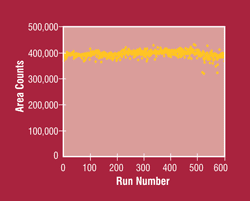
Method Objectives
Oil testing facilities typically run hundreds of thousands of samples each year, thus requiring a fast and robust method for analyzing fuel diluents. This study outlines the principles and technology for such a fast and robust GC method.
The objectives of this study were threefold:
-
Achieve accuracy for compliance with the ASTM and DIN methods referenced.
-
Automate the process to achieve an optimal sample throughput with a more productive time utilization of laboratory technicians.
-
Provide a better means for interpreters to process the data.
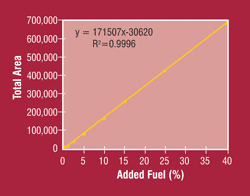
The chromatographic procedure separates components of mixed substances. The process consists of three steps: injection, separation and detection. A sample is injected into a flowing stream of inert gas (mobile phase) in the GC and rapidly vaporizes. The mobile phase then carries the sample onto the analytical column where the separation of the components takes place.
This column consists of an inert solid (fused silica) containing a liquid stationary phase bonded to the surface of the fused silica. Components are separated on the basis of the type of stationary phase in the column, boiling temperature of the components, flow rate of the mobile phase and temperature.
Each component of the mixture interacts with the mobile and the stationary phases. Components with a high affinity to the mobile phase pass through the column first, while components with a higher affinity to the stationary phase are retained on the column longer.
The detector used in this analysis is a flame ionization detector (FID). A small hydrogen flame inside the detector ionizes the components as they pass through the FID. The ions created in this process conduct electricity that is measured through a collector electrode.
As the components pass through the detector, the current (mA) increases and the data is graphically represented as a scan (time vs. mV). The graph is integrated to measure the area under the curve (peak) and quantified based on a standard curve.
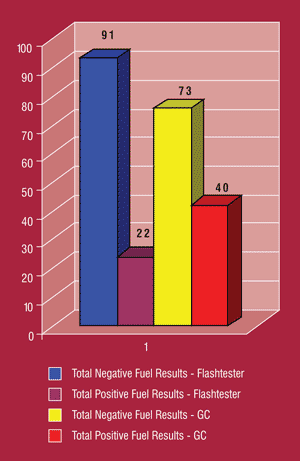
Equipment
The gas chromatograph (GC) used in this study was a PerkinElmer Clarus 500 with a programmable split splitless (PSS) injector, a flame ionization detector (FID) with PreVent, which is used to speed up the analysis by keeping high molecular weight materials from reaching the GC column and detector.
The system is automated and controlled by the data processing station using TotalChrom software. Automation allows the end user to download a sample list, load the automatic sampler, and run the system unattended.
Method
Sample preparation is minimal. The analyst pipettes about 1.0 mL of the neat oil sample into a 2 mL GC vial and then caps it. There are no extraction solvents or other steps involved with the process. Storing and disposing hazardous chemicals normally associated with this type of procedure is avoided.
This technique is made possible through the use of PreVent Mode, a PerkinElmer proprietary sample management system which allows higher boiling components to be injected into the GC while inhibiting those components from migrating through the system. Peak separation is optimized to resolve fuel from oil, but not to resolve individual fuel components, thereby saving time.
Overlap of the fuel range organics with motor oil is defined as n-C4 through n-C12 for gasoline, n-C13 through n-C20 for diesel, and biodiesel elutes just after n-C20. Fuel is, therefore, defined as the lump sum of any volatiles through biodiesel, including gasoline, diesel and biodiesel range fuels. After biodiesel fuel elutes, all higher boiling oil is back-flushed from the head of the column to maintain column life.
Materials, including heavy hydrocarbons and involatile materials that are not flushed from the head of the column, can leave residue or contamination on the analytical column. The current isothermal GC method allows for analysis times of three minutes between injections. This is a tenfold increase in throughput from the standard ASTM GC methods and does not require the labor of the flash point testing method.
The method has shown an excellent linearity range (r2 0.999) of 0.5 to 40 percent diesel fuel dilution (Figure 1). Additive-free Base 75 oil was chosen as the foundation for the standards because of its physical similarity to engine oils. Additive packages do not interfere with the actual analysis, but using unmodified (additized) oil can create a reference that will equally compare all oils. Figure 2 indicates the precision of the results.
Results
In trials at the Caterpillar SOS lab, a series of random used oil samples taken on various days were analyzed. These 175 samples included oils that were flagged by the viscometer for possible fuel dilution as well as oils that were not. The results of these analyses can be broken down as follows:
-
One-hundred thirteen of the 175 samples tested were flagged for a fuel test due to low viscosity. Low oil viscosity can be caused by several mechanisms, not just fuel dilution. Seventy-three of the 113 low viscosity samples tested negative for fuel by both the flash point tester and the CG methods. Twenty-two of the 113 samples tested positive for fuel by both the flash and CG methods. Interestingly enough, the 18 remaining samples that registered negative when tested using the flash tester had values above four percent fuel when tested on the PreVent GC method. Figure 3 shows a comparison of the results using the two techniques. The GC method indicated almost twice as many samples (40 vs. 22) had significant fuel dilution. The PreVent GC methodology indicates it is more sensitive compared to the flash point test methodology as a result of detecting the entire chemical signature of the fuel range from C4-C20. The flash point method relies on the light hydrocarbon vapors igniting and flashing out the flame on the flash point tester.
-
Sixty-two of the 175 samples had acceptable viscosity measurement and were not flagged for fuel dilution testing. Three of these 62 samples had a fuel dilution of more than four percent fuel. Several factors exist why a sample could pass a viscosity test but have an elevated fuel dilution result. Soot, additives or other contaminants in the oil could counteract a low viscosity reading due to fuel dilution, therefore masking the dilution.
-
One sample that was flagged by the viscosity test for possible fuel dilution was also positive when run on the flash point tester, but tested negative for fuel when run on the GC. This sample contained excessive water, and the water vapor caused the flame on the flash tester to extinquish. The flash point tester has a flame. When an oil has fuel, it will flash and extinquish the flame on the flash point tester. The water vapor extinquished the flame on this sample. This is why the result was negative for fuel on the GC.
-
Samples analyzed included oils with excessive water and positive glycol contamination results. These contaminants did not have any adverse effects on the PreVent GC method. Neither of these conditions registered false positives. As previously explained, the presence of these contaminants may possibly extinguish a flame during a flash test analysis.
-
Gasoline engine samples were included in the evaluation.
Important points indicated from the above data include:
-
The GC and flash test results are similar in 84 percent (95 of 113) of the samples that they would normally run due to a low viscosity test triggering a further fuel test. The GC results differ, however, when comparing the 16 percent of the samples that did not correspond. GC analysis adds another 82 percent (18) positive fuel results (40 vs. 22) compared to flash testing.
-
It appears that the viscometer is still an acceptable indicator of fuel dilution. The viscosity test is a screening tool for additional tests. Of the 113 samples, only 22 samples tested positive for fuel using the flash point. Figure 4 shows a comparison of positive fuel results next to the total number of samples run. The two totals are derived from samples that were assigned fuel tests by the SOS Services Manager software and samples that were not.
In Figure 4, yellow is total possible fuel contaminated samples indicated by low viscosity. Green is total fuel contaminated samples indicated by GC. Blue is samples with acceptable normal viscosity, and red is positive fuel dilution with acceptable normal viscosity.
-
Automate the process to achieve a higher sample throughput and better time management of laboratory technicians.
-
Achieve a higher degree of accuracy by providing quantitative and qualitative results.
-
Provide a better means for interpreters to process the data.
The automated GC fuel dilution analyzer provides high throughput testing for fuel diluents in used motor oil for up to 400 samples per day. The cost of the analysis, including less labor and initial startup costs, has been calculated at less than 30 cents per sample.
This method has been tested and verified for the Caterpillar Inc. SOS Internal Laboratories, withstands ruggedness testing, and has provided results that are directly comparable to established methods using known controls.
The GC fuel dilution analyzer has proven to be more accurate and sensitive compared to the flash point method. This allows the results to be monitored and trended like wear metal data. If an interpreter sees a pattern developing, he or she can let the customer know of a possible issue..

any engine oil
LUBRICATING OIL
FORMULATIONS
ENCYCLOPEDİA
is enough.
LUBRICATING OIL FORMULATION ENCYCLOPEDIA has many formulations of greases, complex grease, lithium grease production,sodium greases formula, formulation,multigrade engine oils manufacturing process,motor oils making, gear oil production, synthetic engine oils,semi synthetic motor oils,gasoline oils,diesel oils production process,composition of turbine oils,transmission oil manufacturing, production of cycle motor engine, tractor oils,mineral based motor engine production,heat transfer oils, slideway oils formulation, formulations, cutting oils formula,formulas grinding oils,mould oils manufacturing process and etc.
All lubricating oils in the encyclopedia are producible easily.You need no help and no technıcal support. The encyclopedia is enough to produce lubricating oils and engine oils itself.
LUBRICATING OIL
FORMULATIONS
ENCYCLOPEDIA
is written clear and understandable.


HARD BOOK E BOOK
RELATED TAGS: What is engine oils,making synthetic diesel engine oil,semi synthetic engine oil manufacturing process,mineral based engine oil production, heavy duty engine oil formulation,high performance engine oil formula,formulas,properties of motor oils,synthetic motor oil msds, analysis,composition of engine oils,additives of motor oils, mineral engine oil formulation,make semi synthetic diesel engine oil, base oils,synthetic base oils,light neutral oil,heavy neutral oil,performance additives package, properties of diesel engine oil, how to formulate engine oils, types of engine oils, synthetic motor oils,ingredients of engine oils,compounds of engine oils, index of motor oil,characteristic of motor oils,application of motor oils,combination of synthetic engine oils.
SOLVERCHEM PUBLICATIONS

|
|
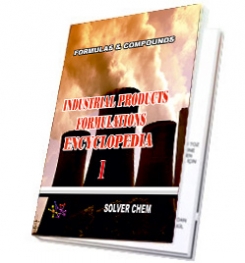
|
|
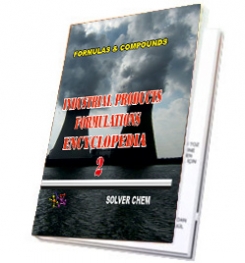
|
|
